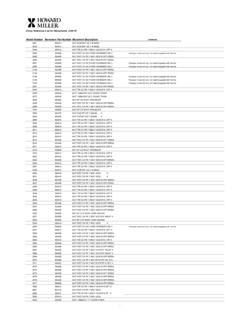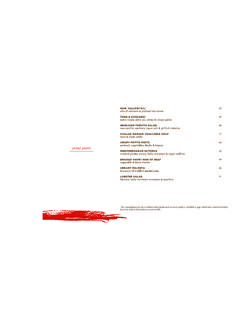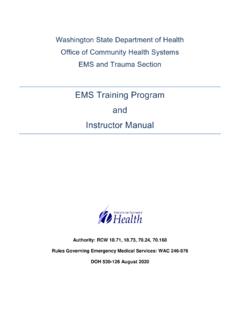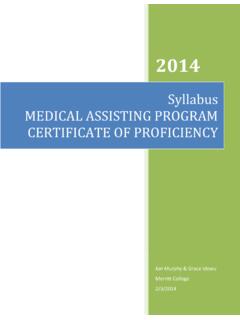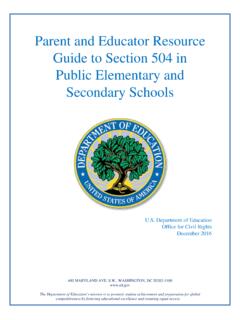Transcription of Infection Prevention, Hazardous Waste Management, and ...
1 Crest + Oral-B at 1 INSTITUTIONAL COURSE NUMBER Infection PREVENTION, Hazardous Waste MANAGEMENT, AND HAZARD COMMUNICATION COMPLIANCE Prototypical syllabus Course Director: Preferred Mode of Communication: Office Location: Office Hours: Course Objective The overall course objective is to present best available evidence-based information to facilitate compliance with and implementation of recommendations made by federal, state/provincial, and local agencies and professional organizations related to Infection prevention, Hazardous Waste management, and hazard communication in oral healthcare settings. The content is intended to meet initial and annual educational requirements as mandated by OSHA and other federal, state, local and professional organizations.
2 The information, as reflected in the 13 modules of the syllabus , is intended to meet (1) individual institutional training requirements of Dental Students, Dental Hygiene Students, and Dental Assistant Students, (2) to serve as the basis for an in-service training program of office personnel, and (3) to be used as a resource by oral healthcare personnel wishing to review evidence-based information on specific topics. Primary Educational Goal The primary educational goal is to provide oral healthcare personnel sufficient knowledge and skills (1) to develop and implement an effective Infection prevention program, (2) to develop and implement an effective Hazardous Waste management program, and (3) to develop and implement an effective hazard communication program. Educational Outcomes Upon completion of the 13 modules, participants should be able to: Understand the purpose and general requirements of OSHA s Standard and Transmission-based Precautions intended to prevent or minimize healthcare-associated infections.
3 Identify those pathogenic organisms that may be transmitted in oral healthcare setting and demonstrate and understanding of the rational for Standard and Transmission-based Precautions based on their modes of transmission. Explain the role of and implement vaccination strategies intended to reduce the risk of vaccine preventable diseases. Explain the role of and implement the use of personal protective equipment to prevent or reduce the risk of healthcare-associated infections. Explain the role of and implement hand hygiene strategies to prevent or reduce the risk of healthcare-associated infections. Crest + Oral-B at 2 Understand the principles of disinfection and sterilization and implement disinfection and sterilization procedures to prevent or reduce the risk of healthcare-associated infections. Recognize the role of and implement environmental Infection control procedures to provide a safer work environment.
4 Understand the principles of and implement strategies for regulated medical Waste management. Describe the importance of post-exposure follow-up and associated policies and establish strategies to reduce the risk of post-exposure healthcare-associated infections. Establish administrative policies to deal with patients and dental professionals with latex allergies and transmissible diseases. Develop and implement a written Infection prevention protocol with special emphasis on issues unique to the oral healthcare setting. Demonstrate/apply in a clinical setting knowledge related to respiratory hygiene/cough etiquette; hand hygiene; donning and removing PPE; preparing the dental treatment room (DTR); DTR turn-around procedures between patients; securing the DTR at the end of the day; and sterilization and disinfection procedures.
5 Understand the purpose and general requirements of EPA s Hazardous Waste Standard; identify Hazardous Waste generated in the oral healthcare setting; and develop and implement a written protocol reflecting best management practices related to Hazardous Waste management. Understand the general requirements of HazCom 2012 and why employers must have a HazCom training program for their employees; identifies parts of the rule that are relevant to oral healthcare settings; and develop and implement a written HazCom program. Outcome Assessment in Educational Settings Predicated on institutional policy, for example: Assessment of educational outcomes related to knowledge gained from the online modules will be based on multiple-choice examinations at the end each module. Assessment of educational outcomes related to clinical skills will be based on the practicum and will be appraised on a pass/fail scale.
6 Students must pass educational outcomes related to both knowledge and clinical skills to pass the course. Grading Policy in Educational Settings Predicated on institutional policy, for example: The responsibility for assigning grades rests exclusively with the Course Director. Students are expected to successfully complete all eleven online modules prior to the Practicum, , the 12th module. Students are allowed as many attempts on modules 1 to 11 as may be necessary to obtain a passing grade (as determined by the Course Director). Attendance Policy in Educational Settings Predicated on institutional policy, for example: The course is designed to accommodate all styles of learning with a blended format, consisting of online learning modules and small group discussion/clinic rotation (Module XII: Practicum).
7 Completion of the online modules is expected prior to the mandated Practicum. Missed Exam/Practicum Policy in Educational Settings Crest + Oral-B at 3 Predicated on institutional policy, for example: If unable to complete the online learning modules in a timely fashion or attend the Practicum, the student must so inform the Course Director and the Office of Student Affairs in writing. Failure to pass the written examination or the Practicum will result in an F grade in the course. Remediation Policy in Educational Settings Predicated on institutional policy, for example: The decision to allow a student to remediate an F grade rests with the Academic Performance Committee. Remediation may be recommended according to the following criteria: If the F grade resulted from failure to satisfactorily complete the online modules and/or the practicum, the student may be allowed to remediate within a specified period of time and will be awarded a grade of D or C.
8 If a student has less than a GPA, but has no F grades, the Academic Performance Committee may allow remediation for a D grade provided a C grade would bring the GPA up to a Crest + Oral-B at 4 Course Contents Module Title Module I ce582 Introduction to Infection Prevention Module II ce479 Mandated, Highly Recommended, and Other Vaccines for Oral Healthcare Personnel Module III ce590 Hand Hygiene Module IV ce483 Personal Protective Equipment Module V ce474 Sterilization and Disinfection of Patient-care Items in Oral Healthcare Settings Module VI ce363 Environmental Infection Prevention and Control Module VII ce498 Regulated Medical Waste Management Module VIII ce472 Postexposure Evaluation and Follow-up Module IX ce473 Infection Control-related Administrative Policies and Work Restrictions Module X ce342 Clinical Practice Guideline for an Infection Control/Exposure Control Program in the Oral Healthcare Setting Module XI ce511 Putting it All Together.
9 Practicum (Video) Module XII ce499 Hazardous (and Universal) Waste Management Module XIII ce502 Hazard Communication Compliance Crest + Oral-B at 5 Other Resources Commission on Dental Accreditation. American Dental Association. Accreditation Standards for Dental Education programs July 1, 2013. ~/media/CODA/ Commission on Dental Accreditation. American Dental Association. Accreditation Standards for Dental Hygiene Education programs January 1, 2013. ~/media/coda/ Commission on Dental Accreditation. American Dental Association. Accreditation Standards for Dental Assisting Education programs January 1, 2014. ~/media/CODA/ Commission on Dental Accreditation of Canada. Accreditation Requirements for Dental Education programs Nov. 30, 2013. Commission on Dental Accreditation of Canada.
10 Accreditation Requirements for Dental Hygiene Education programs Nov. 30, 2011. Commission on Dental Accreditation of Canada. Accreditation Requirements for Dental Assisting Education programs Nov. 30, 2010. Advisory Committee on Immunization Practices American Dental Association American Institute of Architects Academy of Architecture for Health American Society of Heating, Refrigeration, Air-Conditioning Engineers Association for Professionals in Infection Control and Epidemiology, Inc. CDC, Division of Healthcare Quality Promotion Crest + Oral-B at 6 CDC, Division of Oral Health, Infection Control CDC, Morbidity and Mortality Weekly Report CDC, NIOSH CDC Recommends, Prevention Guidelines System EPA, Antimicrobial Chemicals FDA Immunization Action Coalition Infectious Diseases Society of America OSHA, Dentistry, Bloodborne Pathogens Organization for Safety and Asepsis Procedures Public Health Agency of Canada - Disease Prevention and Control Guidelines Society for Healthcare Epidemiology of America, Inc.
